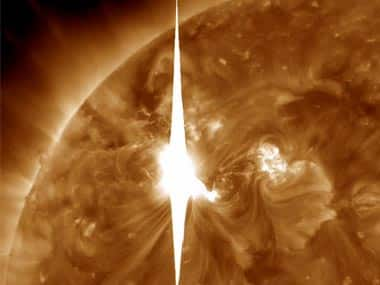The biggest solar flare in five years hit earth on Thursday without any noticeable impact, but scientists say you shouldn’t breathe a sigh of relief just yet.
A report in the Telegraph
warns that the next 18 months could see many more solar storms that are as or more powerful than the one that hit earth, because the sun has entered an active stage in its eleven-year cycle of high and low activity. The report quoted space scientist Maggie Aderin-Pocock as saying, “The sun actually goes through an 11 year cycle, so it has period of high activity and low activity. And we’re just ramping up now to a period of high activity. Although this storm hasn’t caused any damage, there are more to come and they could be more powerful.” [caption id=“attachment_239416” align=“alignleft” width=“380” caption=“This handout image provided by NASA shows a solar flare errupting at 7 p.m. EDT on Tuesday, March 6, 2012: AP”]
 [/caption] Solar storms don’t harm people, but they do disrupt technology. And during the last peak around 2002, experts learned that GPS was vulnerable to solar outbursts. Because new technology has flourished since then, scientists could discover that some new systems are also at risk, said Jeffrey Hughes, director of the Center for Integrated Space Weather Modeling at Boston University. A decade ago, this type of solar storm happened a couple of times a year, Hughes said. “This is a good-size event, but not the extreme type,” said Bill Murtagh, program coordinator for the federal government’s Space Weather Prediction Center. The region of the sun that erupted can still send more blasts our way. Another set of active sunspots is ready to aim at Earth. “This is a big sun spot group, particularly nasty,” NASA’s Hathaway said. “Things are really twisted up and mixed up. It keeps flaring.” Storms like this start with sun spots. First, there’s an initial solar flare of subatomic particles that resembles a filament coming out of the sun. That part usually reaches Earth only minutes after the initial burst, bringing radio and radiation disturbances. Next is the coronal mass ejection, which looks like a growing bubble and takes a couple days to reach Earth. Solar storms have three ways they can disrupt technology on Earth: with magnetic, radio and radiation emissions. In 1989, a strong solar storm knocked out the power grid in Quebec, causing 6 million people to lose power. With inputs from agencies
[/caption] Solar storms don’t harm people, but they do disrupt technology. And during the last peak around 2002, experts learned that GPS was vulnerable to solar outbursts. Because new technology has flourished since then, scientists could discover that some new systems are also at risk, said Jeffrey Hughes, director of the Center for Integrated Space Weather Modeling at Boston University. A decade ago, this type of solar storm happened a couple of times a year, Hughes said. “This is a good-size event, but not the extreme type,” said Bill Murtagh, program coordinator for the federal government’s Space Weather Prediction Center. The region of the sun that erupted can still send more blasts our way. Another set of active sunspots is ready to aim at Earth. “This is a big sun spot group, particularly nasty,” NASA’s Hathaway said. “Things are really twisted up and mixed up. It keeps flaring.” Storms like this start with sun spots. First, there’s an initial solar flare of subatomic particles that resembles a filament coming out of the sun. That part usually reaches Earth only minutes after the initial burst, bringing radio and radiation disturbances. Next is the coronal mass ejection, which looks like a growing bubble and takes a couple days to reach Earth. Solar storms have three ways they can disrupt technology on Earth: with magnetic, radio and radiation emissions. In 1989, a strong solar storm knocked out the power grid in Quebec, causing 6 million people to lose power. With inputs from agencies
More solar flares to hit earth in coming months
FP Staff
• March 9, 2012, 17:13:33 IST
The biggest solar flare in five years hit earth on Thursday without any noticeable impact, but scientists say you shouldn’t breathe a sigh of relief just yet.
Advertisement
)
End of Article